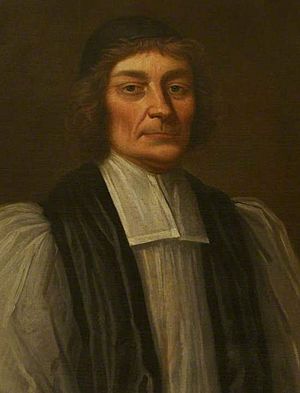William Beveridge (bishop) facts for kids
Quick facts for kids The Right Reverend William Beveridge |
|
|---|---|
| Bishop of St Asaph | |

William Beveridge, posthumous portrait by Benjamin Ferrers
|
|
| Diocese | Diocese of St Asaph |
| In Office | 1704–1708 (death) |
| Predecessor | John Thomas |
| Successor | William Fleetwood |
| Other posts | Archdeacon of Colchester (1681–1704) |
| Personal details | |
| Born | baptized 21 February 1637 Barrow upon Soar, Leicestershire |
| Died | 5 March 1708 (aged 71) Westminster Abbey, London |
| Nationality | British |
| Denomination | Anglican |
| Profession | Clergyman, author |
| Education | Oakham School |
| Alma mater | St John's College, Cambridge |
William Beveridge (1637 – 5 March 1708) was an English writer and church leader. He was known for his work as a clergyman. From 1704 until he passed away, he served as the Bishop of St Asaph.
Contents
Early Life and Education
William Beveridge was born in 1637 in a village called Barrow, near Leicester, England. His family was very involved in the church. His grandfather, father, and older brother John were all vicars (church leaders) there. William's father first taught him at home. Later, he went to Oakham School for two years.
In 1653, when he was 16, William started studying at St John's College, Cambridge. He was very good at learning languages, especially ancient ones. He studied Hebrew, Chaldee, Syriac, and Samaritan. These are old languages from the Middle East. When he was just 21, he wrote a book in Latin about how important these languages were. He also included a grammar guide for the Syriac language.
Becoming a Church Leader
William Beveridge became a deacon in the church in 1661. A deacon is the first step to becoming a priest. He then became a rector (a type of priest) in Ealing from 1661 to 1672. After that, he served as rector of St. Peter's, Cornhill in London until 1704.
He continued to rise in the church. In 1681, he became the Archdeacon of Colchester. An archdeacon helps the bishop manage the church in a certain area. He was known for his sermons (speeches in church). One of his famous sermons was about the importance of the Common Prayer book. This sermon was so popular that it was printed four times. He also gave a well-known sermon about the Great Fire of London in 1666.
In 1689, he became the president of Sion College. This is a college for priests in London.
Bishop of St Asaph
William Beveridge became the Bishop of St. Asaph on 16 July 1704. A bishop is a senior leader in the Christian church. He served in this role until he died on 5 March 1708. He passed away in London, in apartments near Westminster Abbey.
During his life, William Beveridge did not want his picture painted. But after he died, a relative named Benjamin Ferrers painted a portrait of him. This painting is now in the Bodleian Library at Oxford University.
His Writings
William Beveridge was known as a "great restorer of early Christian faith." This is because his sermons and books often focused on the ideas of the early Christian church. His collected works fill 12 volumes. Some of his important writings include:
- The Doctrine of the Church of England Consonant to Scripture, Reason, and the Fathers: A Complete System of Divinity (a two-volume work about the beliefs of the Church of England).
- Private Thoughts on Religion, and Church Catechism Explained (books about personal religious thoughts and explaining the church's teachings).
He also wrote a book about time and dates called Institutionum chronotogicarum libri duo in 1669. In this book, he explained a math problem called the Chinese remainder theorem. This was the first time a general proof for this rule was given.
Images for kids


